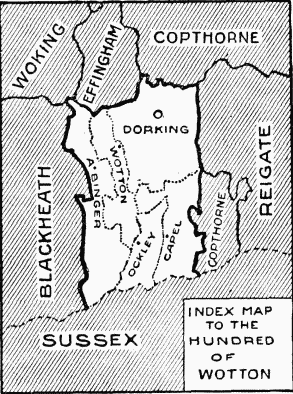A History of the County of Surrey: Volume 3. Originally published by Victoria County History, London, 1911.
This free content was digitised by double rekeying. All rights reserved.
'The hundred of Wotton: Introduction and map', in A History of the County of Surrey: Volume 3, ed. H E Malden (London, 1911), British History Online https://prod.british-history.ac.uk/vch/surrey/vol3/p128 [accessed 1 February 2025].
'The hundred of Wotton: Introduction and map', in A History of the County of Surrey: Volume 3. Edited by H E Malden (London, 1911), British History Online, accessed February 1, 2025, https://prod.british-history.ac.uk/vch/surrey/vol3/p128.
"The hundred of Wotton: Introduction and map". A History of the County of Surrey: Volume 3. Ed. H E Malden (London, 1911), British History Online. Web. 1 February 2025. https://prod.british-history.ac.uk/vch/surrey/vol3/p128.
THE HUNDRED OF WOTTON
CONTAINING THE PARISHES OF
| ABINGER | DORKING | WOTTON (fn. 1) |
| CAPEL | OCKLEY |
Wotton Hundred (fn. 2) (Odeton, xi cent.; Wodetone, until xvi cent.) was found by the Domesday Commissioners to include Dorking, Sutton in Shiere, part of Compton in Sussex, Burgham, Wyke, Worplesdon, Betchworth, Milton, Anstie Farm, Abinger, and Paddington. Of these, Sutton in Shiere was shortly afterwards attached by the Bishop of Bayeux to his manor of Bramley in Blackheath Hundred, (fn. 3) while Compton, as the county borders became more settled, was presumably included in Sussex with the other lands of Roger de Montgomery, who held it at the time of the Survey. It has been suggested that Burgham, Wyke, and Worplesdon owed their inclusion in Wotton Hundred (fn. 4) to a clerical error, and it was possibly due to the same cause that Ockley at the time of the Survey was placed in Woking. It seems probable that 'Becheworth' refers to East Betchworth, now in Reigate Hundred: Milton and Anstie Farm are both in Dorking parish.

INDEX MAP TO THE HUNDRED OF WOTTON
The sheriff's courts were held in Dorking, whence the usual later name. The hundred does not appear to have been alienated from the Crown until it was granted by James I to Sir Edward Zouche, 1620, at the same time and in the same manner as the hundreds of Blackheath and Woking (see under Blackheath Hundred), and likewise descended to Earl Onslow.
